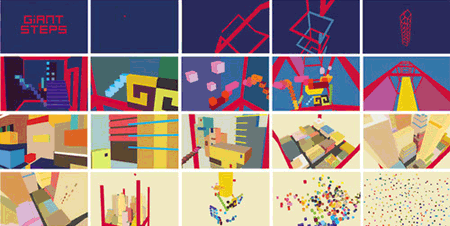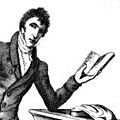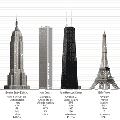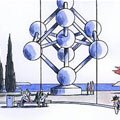vrijdagavond gekocht: John Coltrane Blue Train (Blue Note, 1957)
Dakar (1957) Soultrane (1958) en Black Pearls (1958)
Dakar (1957) Soultrane (1958) en Black Pearls (1958)
Blue Train is a jazz album by John Coltrane, recorded on September 15, 1957 at the Van Gelder Studio. It is considered Coltrane‘s first solo album, as it is the first he recorded featuring musicians and songs entirely of his choosing. All of the compositions were written by Coltrane, save one. The title track is a long, rhythmically variegated blues with a brooding minor theme that gradually shifts to major during Coltrane’s first chorus.
Bron: en.wikipedia.org
Bron: en.wikipedia.org
Blue Train 1957
1. “Blue Train” (Coltrane) – 10:43
2. “Moment’s Notice” (Coltrane) – 9:10
3. “Locomotion” (Coltrane) – 7:14
4. “I’m Old Fashioned” (Kern/Mercer) – 7:58
5. “Lazy Bird”(Coltrane) – 7:00
John Coltrane beschouwde “Blue Train“ als zijn favoriete album. Het is ook de eerste studio-opname waarin wordt gedocumenteerd hoe Coltrane afstand nam van het gestructureerde soleren, zoals dat gemeengoed was geworden. Op “Blue Train“ werkt „Trane„ met sheets of sound, een nieuw concept van de steeds met vormen en concepties spelende Coltrane.
De sessie vond plaats in een drukke en creatieve periode voor Coltrane. Hij speelde elke nacht, en dat al maandenlang, in The Five Spot te New York met het Thelonious Monk Quartet, na meer dan anderhalf jaar vrijwel non-stop met Miles op pad te zijn geweest. Miles ontsloeg hem vanwege zijn heroïneverslaving. Coltrane kickte af en onderging een spirituele wedergeboorte. Nu hij van de heroïne af was, namen ook zijn krachten toe, zijn spel werd geconcentreerder, en Coltrane experimenteerde met lange solo’s en vooruitstrevende ritmische & harmonische concepten.
Coltrane was een jaar voor “Blue Train“ te horen als begeleider van Joe Chambers op het Blue Note-album “Whims Of Chambers“, met Horace Silver, Kenny Burrell, Donald Byrd en Jones. Andere Blue Note’s met Coltrane zijn: “Blowin’ Session“ (1957) van Johnny Griffin, met Hank Mobley, Morgan, Wynton Kelly, Chambers en Art Blakey; en Sonny’s Crib, een sessie voor Sonny Clark, die twee weken voor de Blue Train-sessies werd opgenomen, met Byrd, Fuller, Chambers en Art Taylor.
Bron: bluenote.nl
De sessie vond plaats in een drukke en creatieve periode voor Coltrane. Hij speelde elke nacht, en dat al maandenlang, in The Five Spot te New York met het Thelonious Monk Quartet, na meer dan anderhalf jaar vrijwel non-stop met Miles op pad te zijn geweest. Miles ontsloeg hem vanwege zijn heroïneverslaving. Coltrane kickte af en onderging een spirituele wedergeboorte. Nu hij van de heroïne af was, namen ook zijn krachten toe, zijn spel werd geconcentreerder, en Coltrane experimenteerde met lange solo’s en vooruitstrevende ritmische & harmonische concepten.
Coltrane was een jaar voor “Blue Train“ te horen als begeleider van Joe Chambers op het Blue Note-album “Whims Of Chambers“, met Horace Silver, Kenny Burrell, Donald Byrd en Jones. Andere Blue Note’s met Coltrane zijn: “Blowin’ Session“ (1957) van Johnny Griffin, met Hank Mobley, Morgan, Wynton Kelly, Chambers en Art Blakey; en Sonny’s Crib, een sessie voor Sonny Clark, die twee weken voor de Blue Train-sessies werd opgenomen, met Byrd, Fuller, Chambers en Art Taylor.
Bron: bluenote.nl
Miles Davis en John Coltrane
So what New York, 2 april 1959
So what New York, 2 april 1959
Sheets of sound was a term coined in 1958 by Down Beat magazine jazz critic Ira Gitler to describe the new, unique improvisational style of John Coltrane. Gitler first used the term on the liner notes for Soultrane (1958). Coltrane employed extremely dense improvisational yet patterned lines consisting of high speed arpeggios and scale patterns played in rapid succession: hundreds of notes running from the lowest to highest registers. The lines are often faster than sixteenth notes, consisting of quintuplets, septuplets, etc., and can sound like glissandos.The saxophonist invented this style while playing with Thelonious Monk and later developed it further when he returned to Miles Davis’s group. Both leaders are known to have facilitated a free atmosphere where Coltrane was able to experiment on the bandstand. The saxophonist used the “sheets of sound” lines to emphasize chords, modes, and such harmony.
The music of Miles Davis gave Coltrane the freedom to apply harmonic ideas to stacked chords and substitutions. Further, this open approach allowed Coltrane to arpeggiate three chords simultaneously, a style Monk initially taught Coltrane. The “three-on-one chord approach” gave the music a fluid, sweeping sound that was harmonically vertical. Concepts of vertical (chordal) versus horizontal (melody) are key ideas in the work of George Russell, whom Coltrane had recorded with in September 1958. This approach reflected Coltrane‘s fascination with third relations. Sometimes he used diminished chords, other times he used augmented chords. At times, Coltrane might use scales or licks in the passing keys instead of arpeggios. Coltrane employed these harmonic ideas during his “sheets of sound” stage in 1958. At other times, he would simply play rapid patterns of diminished-scales.
Bron: en.wikipedia.org
The music of Miles Davis gave Coltrane the freedom to apply harmonic ideas to stacked chords and substitutions. Further, this open approach allowed Coltrane to arpeggiate three chords simultaneously, a style Monk initially taught Coltrane. The “three-on-one chord approach” gave the music a fluid, sweeping sound that was harmonically vertical. Concepts of vertical (chordal) versus horizontal (melody) are key ideas in the work of George Russell, whom Coltrane had recorded with in September 1958. This approach reflected Coltrane‘s fascination with third relations. Sometimes he used diminished chords, other times he used augmented chords. At times, Coltrane might use scales or licks in the passing keys instead of arpeggios. Coltrane employed these harmonic ideas during his “sheets of sound” stage in 1958. At other times, he would simply play rapid patterns of diminished-scales.
Bron: en.wikipedia.org
Michal Levy animatie bij Giant Steps 1959
Deze 3D visualisering van Coltrane’s sheets of sounds (Giant Steps) gemaakt door Michal Levy doet Mondriaan’s Broadway Boogie Woogie verbleken.














